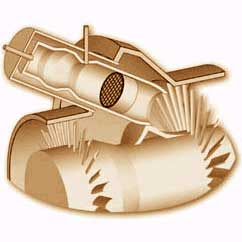Catalysts
 Chemical reactions are interactions between atoms and molecules that result in a change in their relative arrangements and interconnections. The reaction affects only individual atoms and molecules, but even just a small mass of any material contains billions and billions of atoms or molecules. Just one gram of hydrogen gas, for example, contains about 602,235,900,000,000,000,000,000 hydrogen atoms! For an individual reaction to occur, electrons within atomic and molecular bonds must become 'activated' and enter a state that allows the required bonding changes to occur. This new intermediate or transitional state represents a higher energy state of the reacting atoms and molecules, and this poses a barrier to the progress of the individual reactions. Each individual reaction must overcome the 'activation energy' barrier as the overall reaction proceeds through the mass of reacting materials.
Chemical reactions are interactions between atoms and molecules that result in a change in their relative arrangements and interconnections. The reaction affects only individual atoms and molecules, but even just a small mass of any material contains billions and billions of atoms or molecules. Just one gram of hydrogen gas, for example, contains about 602,235,900,000,000,000,000,000 hydrogen atoms! For an individual reaction to occur, electrons within atomic and molecular bonds must become 'activated' and enter a state that allows the required bonding changes to occur. This new intermediate or transitional state represents a higher energy state of the reacting atoms and molecules, and this poses a barrier to the progress of the individual reactions. Each individual reaction must overcome the 'activation energy' barrier as the overall reaction proceeds through the mass of reacting materials.
A catalyst is something that can interact with the reacting materials in such a way that the 'activation energy' barrier of the individual reactions becomes much lower. This usually occurs when reacting atoms or molecules adhere to the surface of the catalyst. The electrons of the affected molecules become partially rearranged in this association of catalyst and substrate, and in a way that is very favorable to the desired reaction. The association of catalyst and substrate is completely reversible. Once formed, the catalyst-substrate complex can dissociate in two ways: either they separate into their original unassociated forms, or they separate as the substrate completes its reaction transformation. In either case, the catalyst returns to its original form. So, while a catalyst becomes very intimately involved in the reaction process, it does not itself undergo a reaction, and is usually recovered intact after a reaction has gone to completion.
Perhaps the most readily known example of the application of a catalytic system is in the 'catalytic converter' of the typical automobile. It's purpose is to complete the combustion of gasoline residues coming from the engine. Under ideal conditions, gasoline would completely oxidized during combustion to produce mostly carbon dioxide and water. But in our less-than-ideal world, combustion is usually incomplete and the exhaust gases contain gasoline hydrocarbon molecules in various states of oxidation. These gases enter the catalytic converter where they pass through a dense honeycomb, with a very large surface area, coated with metals such as platinum or palladium that function very well as catalysts. Their atoms interact well with both hydrocarbons and oxygen, and in joining with the catalyst both become more reactive. When both are present on the catalytic surface, much less energy is needed to bring them into a reactive conformation, and reaction between them is made much easier.
About the Author
Richard M J Renneboog, MS
 Richard M. J. Renneboog is an independent private technical consultant and writer in both chemical and computer applications. Endeavors have included preparation of scripts for instructional and promotional video, corporate website design, curriculum development for training in advanced composites technology, and development.
Richard M. J. Renneboog is an independent private technical consultant and writer in both chemical and computer applications. Endeavors have included preparation of scripts for instructional and promotional video, corporate website design, curriculum development for training in advanced composites technology, and development.


